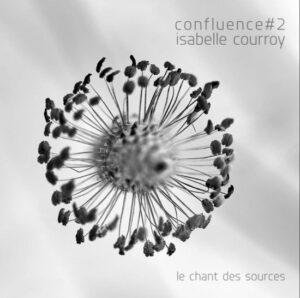
Musicus Isabelle Courroy levert met Le chant des Sources een magische cross-over van traditioneel repertoire uit Armenië, Bulgarije, Griekenland en Turkije.
English version below
Le chant des Sources is de tweede CD met als sub-titel Confluence #2 van Isabelle Courroy. Zij bespeelt de kavel. De prachtig hees klinkende (herders-)fluit. Het instrument komt veel voor op de Balkan en in Turkije en wordt scheef bespeeld en in een hoek van ongeveer 45 graden op de mond geplaatst. De lucht wordt over het instrument geblazen waardoor de toon klinkt; net zoals dat gebeurt op een panfluit. De toonhoogte wordt bepaald door middel van toongaten.
Wie een beetje thuis is in de Bulgaarse, Armeense, Turkse en Griekse muziek, herkent direct de tonaliteit en daarmee de kleur van de muziek, van de liederen. Het is zo fantastisch dat muziek uit landen die verhoudingsgewijs zo dicht bij elkaar liggen zo’n karakteristieke klankkleur hebben en daardoor zo herkenbaar blijven. Dat maakt Europa ook zo’n geweldig werelddeel! Zoals gezegd, Isabelle Courroy bespeelt de kavel en wordt bijgestaan door zo’n twintig musici op o.a. de oud (Arabische luit), nyckelharpa (Zweedse druktoetsen-viool), harp, santour (dulcimer), contrabas en percussie. De melodieën zijn traditioneel en gearrangeerd in een open setting, in een transparante instrumentatie met steeds wisselende bezettingen. Fraai is het lied M’exeis berdemeno, m’exeis dat wordt gezongen door Maria Simoglu waar o.a. een elektrische Arabische luit te horen is, die voor wat verfijnde verstoring zorgt. In Toudoru komt de kavel schitterend tot haar recht in het middendeel. Dit Bulgaarse lied wordt gezongen door Mariyan Pavlova en aangevuld met meerstemmige Bulgaarse zang. Het album Le chant des Sources sluit af met een Armeens lied dat hemelschrijend wordt vertolkt door Francoise Atlan. In deze melodie horen we de drone, de lang-doorklinkende-toon die veelvuldig in Armenië wordt gebruikt bij het duduk-spel (dubbelrietinstrument) werken. In dit lied, Sareri, wordt de drone gespeeld op een strijkinstrument.
Zo’n dertig jaar geleden ontdekte Isabelle Courroy de schoonheid van de kavel. Haar fascinatie ging uit naar de eenvoud van dit unieke instrument: een houten buis met gaten die je zijwaarts bespeelt. Die eenvoud is de kracht van dit instrument waar je je ziel in kan leggen en het persoonlijk en authentiek kunt bespelen. En dat is precies wat Isabelle Courroy doet in een hedendaagse mix van bijzondere muziek uit Armenië, Bulgarije, Griekenland en Turkije.
Full album – click on YouTube below
English version
Musician Isabelle Courroy recorded the magical album Le chant des Sources. A fine rossover with traditional repertoire from Armenia, Bulgaria, Greece and Turkey.
Le chant des Sources is the second CD with the sub-title Confluence #2 by Isabelle Courroy. She plays the kaval. The beautifully hoarse sounding (shepherd’s) flute. The instrument is common in the Balkans and Turkey and is played at an angle of about 45 degrees on the mouth. The air is blown over the instrument causing the tone to sound; just like on a pan flute. The pitch is determined by tone holes.
Anyone who is somewhat familiar with Bulgarian, Armenian, Turkish and Greek music, will immediately recognize the tonality and thus the color of the music, of the songs. It is so fantastic that music from countries that are relatively so close to each other, have such a characteristic timbre and therefore remain so recognizable. That’s what makes Europe such a great continent! As mentioned, Isabelle Courroy plays the kaval, but she is assisted by about twenty musicians on the oud (Arabic lute), nyckelharpa (Swedish keyboard violin), harp, santour (dulcimer), double bass and percussion. The melodies are traditional and arranged in an open setting, in a transparent instrumentation with constantly changing line-ups. Great is M’exeis berdemeno, m’exeis, which is beautifully sung by Maria Simoglu. In this song an electric Arabic lute can be heard, which provides some refined disturbance. In Toudoru, the kaval comes up beautifully in the middle part. This Bulgarian song is sung by Mariyan Pavlova and supplemented by polyphonic Bulgarian vocals. The album Le chant des Sources closes with an Armenian song that is performed heartbreakingly by Francoise Atlan. In this nice melody we hear the drone, the long-sounding tone that is often used in Armenia in the duduk (double reed instrument) pieces. In this song, Sareri, the drone is played on a string instrument.
About thirty years ago Isabelle Courroy discovered the beauty of the kaval. She was fascinated by the simplicity of this unique instrument: a wooden tube with holes that you have to play sideways. But that simplicity is the power of this instrument that you can put your soul into and play it personally and authentically. And that is exactly what Isabelle Courroy does in a contemporary mix of special music from Armenia, Bulgaria, Greece and Turkey.
- Isabelle Courroy: Le chant des Sources / Confluence #2 (Buda Records / Xango)
- B/W picture by M¢Richard Carrée
© Mattie Poels.

Geen reacties